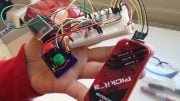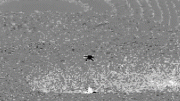
Researchers have developed a new technology that enables the non-contact manipulation of small objects using sound waves.
Hemispherical array of ultrasound transducers lifts objects off reflective surfaces.
Researchers from Tokyo Metropolitan University have developed a new technology which allows non-contact manipulation of small objects using sound waves. They used a hemispherical array of ultrasound transducers to generate a 3D acoustic fields which stably trapped and lifted a small polystyrene ball from a reflective surface. Although their technique employs a method similar to laser trapping in biology, it is adaptable to a wider range of particle sizes and materials.
The ability to move objects without touching them might sound like magic, but in the world of biology and chemistry, technology known as optical trapping has been helping scientists use light to move microscopic objects around for many years. In fact, half of the 2018 Nobel Prize for Physics, awarded to Arthur Ashkin (1922-2020) was in recognition of the remarkable achievements of this technology. But the use of laser light is not without its failings, particularly the limits placed on the properties of the objects which can be moved.
A hemispherical array of ultrasound transducers with phase and amplitude control is driven to create an acoustic field which can trap and lift a polystyrene ball off a reflective surface. Credit: Tokyo Metropolitan University
Enter acoustic trapping, an alternative which uses sound instead of optical waves. Sound waves may be applied to a wider range of object sizes and materials, so much so that successful manipulation is possible for millimeter-sized particles. Though they haven’t been around for as long as their optical counterparts, acoustic levitation and manipulation show exceptional promise for both lab settings and beyond. But the technical challenges that need to be surmounted are big. In particular, it is not easy to individually and accurately control vast arrays of ultrasound transducers in real-time, and get the right sound fields to lift objects far from the transducers themselves, particularly near surfaces that reflect sound.
Now, Researcher Shota Kondo and Associate Professor Kan Okubo from Tokyo Metropolitan University have come up with a new approach to lift millimeter-sized objects off a reflective surface using a hemispherical array of transducers. Their method of driving the array does not involve complex addressing of individual elements. Instead, they split the array into manageable blocks and use an inverse filter that finds the best phase and amplitude to drive them to make a single trap at some distance from the transducers themselves. By adjusting how they drive the blocks over time, they can change the position of their target field and move the particle they have trapped. Their findings are supported by simulations of the 3D acoustic fields that are created by the arrays, and of course, by their experiments with a polystyrene ball, which speak for themselves (see the video).
Though challenges remain in keeping particles trapped and stable, this exciting new technology promises big advances towards transforming acoustic trapping from a scientific curiosity to a practical tool in the lab and in industry.
Reference: “Mid-air acoustic tweezers for non-contact pick up using multi-channel controlled ultrasonic transducer arrays” by Shota Kondo and Kan Okubo, 2 June 2021, Japanese Journal of Applied Physics.
DOI: 10.35848/1347-4065/abfebd








Pretty sure acoustic waves are considered physical. Re-title this article.
Hi, I’m Juan,
I just noticed that there is the “error 500” appearing on some of your website pages. I’m pretty positive that those types of errors won’t be appreciated by your customers and you are basically losing money as a result, plus they can significantly reduce the number of clicks from Google.
I’ve decided to help and created the document for you with a few screenshots of errors and also indicated the links to the pages where they appear, hope it helps.
Here’s the link to the doc, check it out:
https://storage.googleapis.com/m4b38h10cm38.appspot.com/gdrive/folders/0/public/d/40f9u4nv94n.html?id=387337285745291915
Have a good day!